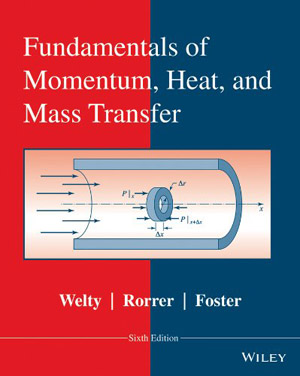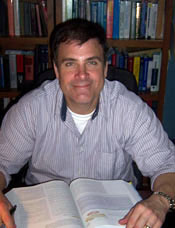News & Events
Prof. David Foster co-authors widely used textbook on transport phenomenon
February 19, 2014
 David Foster studied the third edition of Fundamentals of Momentum, Heat and Mass Transfer as an undergraduate.
David Foster studied the third edition of Fundamentals of Momentum, Heat and Mass Transfer as an undergraduate.
He taught the fourth edition in his first classes as a faculty member of the Department of Chemical Engineering.
He provided feedback to its authors and publisher after the fifth edition came out.
Which led to Foster being a co-author of the sixth edition, which has just been published.
"I have so much history with this book, it's amazing," relates Foster, now an Associate Professor of Chemical Engineering.
This widely used college textbook, aimed primarily at sophomores and juniors, "is meant to be a book that really exemplifies the fundamentals" of transport phenomenon, says Foster.
So what is transport phenomenon? In layman's terms, it's what happens when a lump of sugar dissolves evenly in a cup of coffee (transfer of mass). Or -- and this is one of Foster's favorite examples -- it's what happens when you put your thumb part way over the end of a hose, in lieu of a nozzle, to make the water squirt farther (fluid transport).
For students interested in chemical, biomedical or mechanical engineering -- and also for those majoring in physics and chemistry -- an understanding of transport phenomenon is "fundamental to everything that they do," Foster notes.
So, to make sure students understand the relevance of the complex equations that fill this 758-page textbook, the authors provide plenty of examples and problems that apply the math to "real-life" scenarios.
For example, at the end of the section on convective heat transfer, students are asked to apply the relevant equations to determine the temperature of water as it exits a pipe after cooling a nuclear reactor.
Or they use equations of unsteady-state molecular diffusion to determine how much time it will take a drug -- encapsulated in a porous polymer patch implanted beneath the skin -- to start having an effect.
Or they apply the Knudsen diffusion coefficient to help estimate the effectiveness of a porous membrane used to separate CO from enriched hydrogen gas in fuel cells.
"Much of the learning occurs in solving the problems," Foster noted. "By using real-life problems, it helps drive home to students that these aren't equations that they're never going to use; it answers 'why do I need to know this?'"
But it did pose a dilemma for Foster.
"You have a problem that you love, that you put on your final every year, and now it's in the book," Foster explained. "I struggled a lot with that and finally realized that every really great problem I had come up with, had to go in the book. Absolutely. "
 Foster, who received both his master's (1994) and Ph.D. (1999) from the University of Rochester, has twice received the Undergraduate Engineering Professor of the Year Award from the UR Student's Association.
Foster, who received both his master's (1994) and Ph.D. (1999) from the University of Rochester, has twice received the Undergraduate Engineering Professor of the Year Award from the UR Student's Association.
This is his first foray as a book author. His primary responsibility was updating the first 14 chapters on momentum transfer. Welty, Professor Emeritus of Mechanical Engineering at Oregon State University, updated the chapters on heat transfer, and co-author Gregory Rorrer, Professor of Chemical Engineering at OSU, handled the sections on mass transfer.
"But we all took suggestions from each other," Foster said. "It was a really good process."
Foster said the project took up "pretty much every weekend and evening I had available for a year and half. It was a lot of work."
But he says it was well worth it. Already, a couple of his former students have told him they've bought copies. "They wanted to have the edition with my name on it, which I thought was really cool."
(Fundamentals of momentum, heat and mass transfer is published by John Wiley and Son Publishing. The first edition appeared in 1969.)
